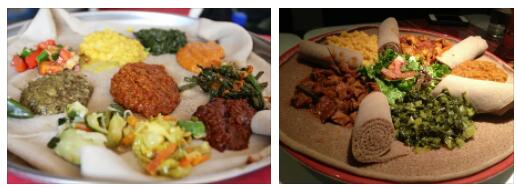Many ethnic groups live in Ethiopia such as the Amharen, the Tigray, the Oromo, the Somali, the Afar or the inhabitants of southwest Ethiopia, the Nilots. 70 out of 100 people belong to the first three ethnic groups. Many ethnic groups again consist of subgroups. They are connected by a common language.
These population groups differ not only in appearance, but also in their customs and traditions. The Tigray are usually tall and slim and have narrow faces. The women, like the women of the Amharen, often wear braids that are artfully braided and lie right on the head.
As nomads, the Somali mostly move around in the southeast of Ethiopia. Most Somali, however, live in Somalia, Djibouti and northern Kenya. But here too there are groups that are related to them. The Somali almost always belong to Islam.
The Afar settle in the Danakil Depression. They used to move around with their herds of camels, but now also breed cattle or trade in salt. Men usually wear long robes and, in the old tradition, dye their beards red. Whoever wears a feather in his hair has killed an enemy. Polygamy – a man marries several women – is still widespread here.
Some of these peoples consist of only a few people, others of very many. In the country they often live in family huts. All life takes place in these huts: cooking, working, leisure. That is why these huts are the center of life for the people.
Life like before
Many people in Ethiopia still live according to very old traditions. They usually feel closely connected to nature and often shape their existence in a sustainable manner without exploiting nature. This is how their ancestors showed them how to do it.
However, the modern age is also moving into the old villages. There are economic interests, for example selling the forest. The change within society is evident in the cutting down of the trees. One consequence is the destruction of the soil. Even the climate change leading to drought and death of animals and humans, makes itself increasingly felt.
The independence of the Ethiopian culture is certainly also due to the fact that Ethiopia was never a colony and thus the influence of the Europeans was much less than in countries with a long colonial tradition.
Painting, scars and elaborate hair
But many a tradition seems alien to us and often appears brutal and not according to our ideas. So many men carry marks on them that they have killed enemies. We are very proud of that. With some peoples there are scars that are added to each other as jewelry. Body paint is important and cuts on arms and legs are a testimony to the number of enemies killed.
Body jewelry is also very important. The tribes of the Surma and Karo are painted on the face, on the chest and on the arms and legs. To do this, they use colors from nature.
Hair is often true works of art. Women smear mud and butter into their hair and twist it into little curls. Or the hair is shaped into caps with clay and then decorated with feathers.
Even lips that are formed into plates or enlarged earlobes, which are filled with jewelry, feel the people as beautiful. There are also many festivals and ceremonies that differ depending on the tribe.
But tastes are known to be different, it is the same all over the world.
Eating in Ethiopia
What do you eat in Ethiopia?
Ethiopian cuisine differs from that of the other countries south of the Sahara. Thin, soft flatbreads called injera are very important. These are made from teff, a specific type of millet. These flat cakes are served with sauces, which can consist of vegetables and legumes, but also meat.
To eat the sauce you don’t use a knife and fork, but the flatbread. So you tear off a piece of the flatbread and use it to pick up the sauce – but only with your right hand! The Ethiopians eat these cakes with almost every meal. The 40 to 50 centimeter flat cakes are baked on clay plates.
Those who like it spicy will get their money’s worth
You can also serve a very hot spice mixture called Berbere, which consists largely of ground chili peppers. Most of the dishes in Ethiopia are pretty spicy, by the way. People like to use cinnamon and ginger, but also cloves and chilli, which give the dishes the spiciness.
In traditional rural families, parents and children gather in one room and place a woven basket in the middle of the chairs with a bowl on which everyone can eat together.
No pork meat!
Incidentally, not only the Islamic cuisine forbids pork, but also the Ethiopian Orthodox, which is why only poultry, lamb and sheep, beef or camel are served as meat dishes. Fish is also allowed.
